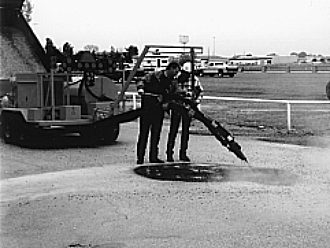U.S. Department of Transportation
Federal Highway Administration
1200 New Jersey Avenue, SE
Washington, DC 20590
202-366-4000
Focus
| Accelerating Infrastructure Innovations |
Publication Number: FHWA-RD-99-105
Date: June/July 1999
New machines and materials, however promising, can be risky for highway agencies. After all, until an agency actually tries it out, there's no knowing how well it will serve the agency's needs or be received by its staff. To give State and local agencies a hands-on look at new pavement maintenance techniques and materials, the Lead States team for innovative pavement maintenance materials is conducting, for the second year, a series of field demonstrations.
Field demonstrations give agencies with limited budgets the confidence to invest in innovation. "It's one thing to look at glossy cover shots," said Lee Smithson of the Iowa Department of Transportation (DOT) and the Lead States team leader. "But it's another to put a machine into the field where people who know how to use it work shoulder-to-shoulder with people who are interested in knowing. And we try to hold these events as near as possible to State borders so that other States with limited budgets can also send people."
On April 18-19, the Lead States team held a field demonstration at a exposition in Ames, Iowa. The event offered nearly 900 people from the Iowa DOT, county and city agencies, and other States the chance to see what Smithson called "field demos put on by people who actually use the products and procedures." After an afternoon of classes covering everything from excavation safety to mowing and herbicides, the participants moved outside the next morning to look at innovative pavement maintenance techniques and materials, including spall patching, pothole patching, and crack and joint sealing. As John Selmer of Iowa DOT and a Lead States team member notes, the demo focused on "meeting the needs of the equipment users."
A second field demonstration was held in Boise, Idaho, on April 29. Participants from Idaho, Oregon, and Washington State traveled to the Western Idaho Fairgrounds, where they spent the morning in classes and the afternoon in the field. Focused on pavements, this event promoted early preventive maintenance strategies.
Organizers "encouraged participants to consider alternatives to standard seal coats and chip coats, such as slurry seals and microseals," says Clayton Sullivan of Idaho DOT and a member of the Lead States team. Slurry seals, which had been proven effective by the Strategic Highway Research Program (SHRP), require no rolling and create no dust. Microseals, brought from Europe especially for use in filling wheel ruts, offer the advantage of rapid setting, often allowing traffic to return within 1 hour after application. Other products featured included a SHRP-evaluated two-part polymer for concrete pavement repair and a cost-effective treatment for sealing cracks in asphalt pavement. "People tend not to seal cracks correctly," said Sullivan, "and we demonstrated to them how to do it."
Both events highlighted velocity-fill pothole patchers, automated devices that propel aggregate and asphalt through a hose at high velocity and compact patches without using a compactor. These automated pothole patchers were also found highly effective and efficient by SHRP.
The field demonstrations, said Smithson, are "win-win situations. The vendors can demonstrate their products in the field, State champions can demonstrate technologies to other agencies, and learners benefit most of all. This is effective technology transfer."
A third Lead States field demonstration was held in southeastern Pennsylvania on May 12. Approximately 60 people from Pennsylvania, Delaware, Maryland, and New Jersey gathered in Concordville, Pennsylvania, to see pavement maintenance equipment demonstrations by both users and vendors. Attendees included State highway agency personnel, city and county highway workers, engineering consultants, and equipment vendors and contractors. The City of Philadelphia demonstrated its portable pothole recycling equipment, while Delaware DOT operated its velocity spray injection pothole patcher and Pennsylvania DOT brought in a crew from Lancaster County to demonstrate its pothole repair machine. In addition, two manufacturers demonstrated the latest in crack sealing/filling equipment.
"Bringing technology in action to the people who need it was a huge success," says Joseph Huerta of FHWA. "There were many enthusiastic recommendations that similar workshops be held." As a result, Pennsylvania DOT and FHWA are planning to hold another demonstration this fall.
For more information on the field demonstrations or the Lead States team on innovative pavement maintenance materials, contact John Selmer at Iowa DOT (phone: 515-239-1589; fax: 515-239-1005; email: jselmer@max.state.ia.us), Clayton Sullivan at Idaho DOT (phone: 208-334-8405; fax: 208-334-8595; email: csulliva@itd.state.id.us\), or Don Wise, Pennsylvania DOT (phone: 717-787-6226; fax: 717-705-5520).

An April field demonstration held by the Lead States team for innovative pavement maintenance in Boise, Idaho, highlighted use of the velocity-fill pothole patcher.